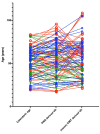Comparison of Functional and Morphological Estimates of Vascular Age
- PMID: 37652489
- PMCID: PMC10500512
- DOI: 10.21873/invivo.13317
Comparison of Functional and Morphological Estimates of Vascular Age
Abstract
Background/aim: Vascular age (VA) is an emerging metric in preventive cardiovascular (CV) medicine. VA can be derived from morphological parameters such as carotid intima-media thickness (CIMT), or functional parameters such as pulse wave analysis (PWA), which celebrates its 100th birthday. This study aimed to investigate whether the results of both approaches are comparable.
Patients and methods: On the occasion of the double 100th anniversary of PWA and the Mannheim Clinic, 100 volunteers underwent a) bilateral CIMT assessment using high-resolution ultrasound and b) oscillometric PWA at the brachial forearm site. The respective VAs were calculated using previously published equations.
Results: Median age of the participants was 53.6 years (range=39.8-62.6 years), and 56% were female. Median CIMT was 632.5 μm (range=548.8-730.0 μm). Median PWA-derived VA was 55.3 years (36.5-70.5 years). Different values were obtained for CIMT-derived VA, depending on the reference cohort used as calculation basis, ranging from median 43.7 (26.2-59.5 years) to median 64.0 years (43.5-82.1 years). In 46% of the participants divergent VAs were found, that is, the calculated age was higher according to one method and lower according to the other. Correlation analysis revealed a strong dependence of VA (both PWA- and CIMT-derived) and chronological age, as well as an increase in CV risk factors and the detection of plaques with age.
Conclusion: Different approaches for estimating VA are not comparable and often produce contradictory results. The current methods and their validity must be critically assessed if they are not standardized.
Keywords: Vascular age; arterial stiffness; carotid ultrasound; intima-media thickness; pulse wave analysis.
Copyright © 2023, International Institute of Anticancer Research (Dr. George J. Delinasios), All rights reserved.
Conflict of interest statement
G. Schumacher is one of the founders and chief executive officers of inmediQ Gesellschaft mit beschränkter Haftung (Butzbach, Germany), which distributes the device (VascAssist) used in this study. All other Authors declare that they have no competing financial interests or personal relationships that could have influenced the work reported in this study.
Figures



References
-
- Roth GA, Mensah GA, Johnson CO, Addolorato G, Ammirati E, Baddour LM, Barengo NC, Beaton AZ, Benjamin EJ, Benziger CP, Bonny A, Brauer M, Brodmann M, Cahill TJ, Carapetis J, Catapano AL, Chugh SS, Cooper LT, Coresh J, Criqui M, DeCleene N, Eagle KA, Emmons-Bell S, Feigin VL, Fernández-Solà J, Fowkes G, Gakidou E, Grundy SM, He FJ, Howard G, Hu F, Inker L, Karthikeyan G, Kassebaum N, Koroshetz W, Lavie C, Lloyd-Jones D, Lu HS, Mirijello A, Temesgen AM, Mokdad A, Moran AE, Muntner P, Narula J, Neal B, Ntsekhe M, Moraes de Oliveira G, Otto C, Owolabi M, Pratt M, Rajagopalan S, Reitsma M, Ribeiro ALP, Rigotti N, Rodgers A, Sable C, Shakil S, Sliwa-Hahnle K, Stark B, Sundström J, Timpel P, Tleyjeh IM, Valgimigli M, Vos T, Whelton PK, Yacoub M, Zuhlke L, Murray C, Fuster V, GBD-NHLBI-JACC Global Burden of Cardiovascular Diseases Writing Group Global burden of cardiovascular diseases and risk factors, 1990-2019: Update from the GBD 2019 study. J Am Coll Cardiol. 2020;76(25):2982–3021. doi: 10.1016/j.jacc.2020.11.010. - DOI - PMC - PubMed
-
- Lucaroni F, Cicciarella Modica D, Macino M, Palombi L, Abbondanzieri A, Agosti G, Biondi G, Morciano L, Vinci A. Can risk be predicted? An umbrella systematic review of current risk prediction models for cardiovascular diseases, diabetes and hypertension. BMJ Open. 2019;9(12):e030234. doi: 10.1136/bmjopen-2019-030234. - DOI - PMC - PubMed
-
- Piepoli MF, Hoes AW, Agewall S, Albus C, Brotons C, Catapano AL, Cooney MT, Corrà U, Cosyns B, Deaton C, Graham I, Hall MS, Hobbs FDR, Løchen ML, Löllgen H, Marques-Vidal P, Perk J, Prescott E, Redon J, Richter DJ, Sattar N, Smulders Y, Tiberi M, van der Worp HB, van Dis I, Verschuren WMM, Binno S, ESC Scientific Document Group 2016 European Guidelines on cardiovascular disease prevention in clinical practice: The Sixth Joint Task Force of the European Society of Cardiology and Other Societies on Cardiovascular Disease Prevention in Clinical Practice (constituted by representatives of 10 societies and by invited experts) Developed with the special contribution of the European Association for Cardiovascular Prevention & Rehabilitation (EACPR) Eur Heart J. 2016;37(29):2315–2381. doi: 10.1093/eurheartj/ehw106. - DOI - PMC - PubMed
MeSH terms
LinkOut - more resources
Full Text Sources
